When it comes to choosing the right trailer, the decision often comes down to one critical feature: the axle configuration. Understanding the difference between a single axle and a tandem axle trailer can help you make a smarter, safer investment.
Both single axle and tandem axle trailers are used for hauling, but they serve very different needs. A single axle trailer has one set of wheels, while a tandem axle trailer has two sets. This difference affects everything—from how much weight the trailer can carry to how smoothly it rides on the road.
Whether you’re hauling construction materials, landscaping equipment, or recreational gear, the type of axle you choose can impact your driving experience, cost of ownership, and long-term durability.
What Is a Single Axle Trailer?
A single axle trailer is designed with just one axle and a pair of wheels, usually located near the center of the trailer’s body. This design makes it lighter, simpler, and easier to tow for many drivers.
Key Features:
- One axle with two wheels
- Compact and lightweight frame
- Typically easier to park and maneuver
Because of its simpler build, a single axle trailer is best for lighter loads. It’s a favorite for people who use trailers occasionally—like homeowners, small business owners, or those hauling tools and supplies for weekend jobs.
Pros of Single Axle Trailers:
- Lower cost: Both the upfront cost and maintenance are more affordable.
- Easier to tow: Their lightweight nature means less stress on your vehicle and better fuel efficiency.
- Less maintenance: Fewer wheels and parts mean fewer repairs.
- Better maneuverability: Great for tight spaces and short trips.
Cons of Single Axle Trailers:
- Limited load capacity: Not ideal for carrying heavy or bulky items.
- Less stable: Can be harder to control on highways or uneven terrain.
- Faster tire wear: With only two tires, wear and tear can happen more quickly.
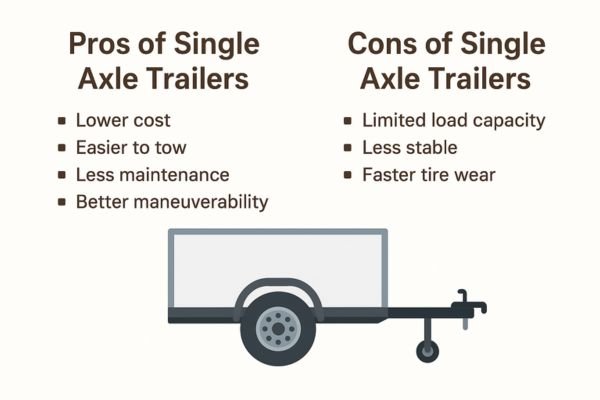
What Is a Tandem Axle Trailer?
A tandem axle trailer features two axles, typically spaced close together, with four wheels instead of two. This setup allows the trailer to carry heavier loads while offering better stability, especially at higher speeds or on rough roads.
Key Features:
- Two axles and four wheels
- Designed for heavy-duty use
- Built for longer distances and commercial hauling
Because a tandem axle trailer can handle more weight, it’s ideal for contractors, farmers, or anyone needing a trailer for frequent or demanding work.
Pros of Tandem Axle Trailers:
- Greater load capacity: Can haul significantly more weight than a single axle trailer.
- Improved stability: Less swaying and better control at high speeds
- Durable build: Built to last through frequent or heavy use.
- Safer on the road: Especially when carrying uneven or heavy loads.
Cons of Tandem Axle Trailers:
- Higher cost: The initial price and long-term maintenance are more expensive.
- Heavier weight: Puts more strain on the tow vehicle and can reduce fuel efficiency.
- Harder to maneuver: Requires more space to park or turn.
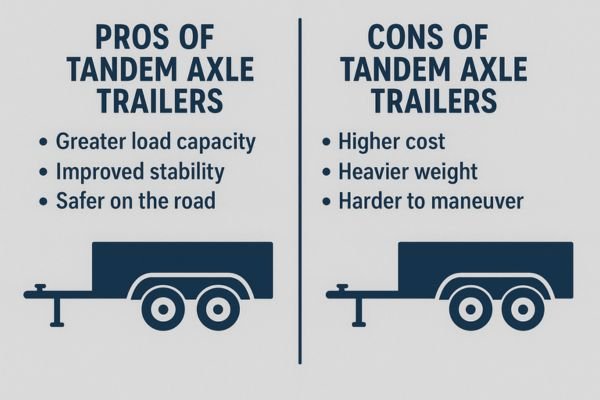
Performance Comparison: Single Axle vs Tandem Axle
Understanding how a trailer performs under different conditions is essential before choosing one. Here’s how single axle and tandem axle trailers stack up across key areas:
Towing and Handling
- A single axle trailer is easier to tow because it’s lighter and has less drag. It’s easier to turn, back up, and park. This makes it great for beginners or those who tow occasionally.
- A tandem axle trailer, while harder to maneuver in tight spots, offers more stability at higher speeds. It stays more balanced during windy conditions or when driving on uneven ground.
Weight Distribution and Load
- Single axle trailers can carry lighter loads—usually up to 3,500 lbs, depending on the frame and axle strength. If you overload them, they can become unstable and unsafe.
- Tandem axle trailers are made for heavy-duty tasks. They can usually handle between 5,000 to 12,000 lbs or more, depending on the axle rating. The extra axle allows weight to be spread more evenly, reducing wear on each tire and enhancing safety.
Ride Comfort and Safety
- With only two tires, a single axle trailer might bounce more over bumps or potholes. The ride can feel rougher, especially if the trailer is empty.
- Tandem axle trailers provide a smoother ride. With four tires on the ground, they absorb more of the road’s impact. This not only protects the trailer but also the cargo inside.
Tire and Suspension Wear
- A single axle trailer has fewer parts—only two tires and one suspension system. This means less wear overall, but more stress per tire.
- Tandem axle trailers distribute the weight across more tires, leading to slower wear. However, they come with more moving parts, so repairs may cost more when needed.
Legal and Licensing Considerations
Regulations vary by region, but here are the basics to keep in mind:
Weight Limits and Load Ratings
- Single axle trailers are often exempt from stricter licensing or permit requirements because they stay under most gross vehicle weight thresholds.
- Tandem axle trailers can exceed these limits, which may require special licensing or inspections depending on your state or country.
For example, many U.S. states require trailers over 3,000 lbs to be registered, and in some cases, equipped with brakes. Tandem axle trailers are more likely to fall into this category due to their heavier builds and higher capacity.
Braking Requirements
- Some single axle trailers under 2,000–3,000 lbs do not need their own brakes.
- Most tandem axle trailers are required to have their own brake systems. This is because the extra weight can’t be safely managed by the towing vehicle alone.
Insurance and Registration Costs
- You’ll typically pay less to insure and register a single axle trailer due to its lower value and load capacity.
- A tandem axle trailer may come with higher insurance premiums because of the potential risks associated with hauling heavier loads.
Cost Comparison: Upfront and Long-Term
One of the biggest differences between a single axle and a tandem axle trailer comes down to cost. But price doesn’t just mean the purchase—it also includes repairs, maintenance, and operating expenses over time.
Initial Purchase Price
- A single axle trailer is less expensive. It’s built with fewer parts—fewer tires, one axle, and a simpler frame. This makes it attractive to buyers on a budget or those who don’t need to haul heavy loads.
- A tandem axle trailer costs more upfront. But for those who need to move larger, heavier equipment regularly, the price can be worth it for the added strength and capacity.
Maintenance and Repair Costs
- Fewer parts mean fewer problems. That’s the appeal of a single axle trailer. You’ll spend less on routine maintenance, and when repairs are needed, they tend to be cheaper.
- Tandem axle trailers require more maintenance. You have four tires to replace instead of two. Brake systems are more complex. And additional suspension components may need servicing over time.
Long-Term Value
- If you only use your trailer occasionally or for smaller loads, a single axle trailer will likely save you money over its lifetime.
- If you’re a contractor, hauler, or frequent traveler, a tandem axle trailer can deliver better value long-term. It’s more durable and offers better resale potential due to its higher demand in heavy-duty markets.
Best Use Cases for Each Axle Type
Choosing between a single axle and a tandem axle trailer doesn’t come down to which one is “better.” It comes down to which one fits your needs. Each type shines in different situations. Here’s how to decide which axle configuration matches your typical use case:
When to Choose a Single Axle Trailer?
If you’re looking for something lightweight, easy to tow, and affordable, a single axle trailer may be the better fit. Here are some examples where it makes sense:
- Home improvement projects: Hauling a small load of lumber, drywall, or tools around town.
- Weekend landscaping jobs: Transporting a lawn mower, bags of mulch, or garden tools.
- Recreational use: Towing bicycles, kayaks, camping gear, or a lightweight ATV.
- Small business deliveries: Carrying limited loads that don’t exceed the trailer’s weight capacity.
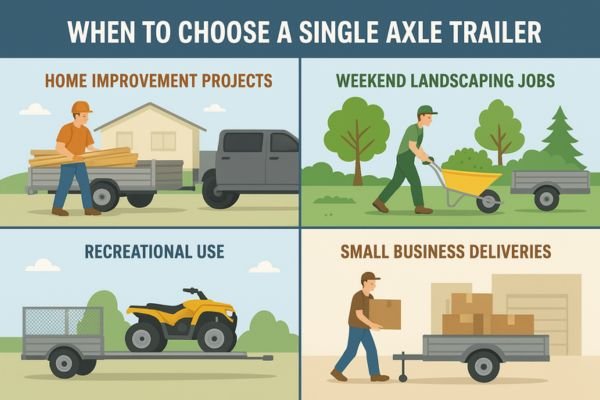
A single axle trailer is a great option if you drive short distances, stay on well-paved roads, and don’t plan to haul more than around 3,000 pounds. Its lighter design also helps improve gas mileage and reduces wear on your vehicle’s engine.
When to Choose a Tandem Axle Trailer?
If you regularly haul large or heavy loads—or travel long distances—a tandem axle trailer is likely the better investment. Use cases include:
- Construction and contracting: Moving heavy tools, cement mixers, lumber, and other building supplies.
- Agriculture and farming: Transporting hay, feed, livestock supplies, or small tractors.
- Long-distance hauling: For users who spend hours on the highway, the extra wheels and stability matter.
- Vehicle or equipment transport: Towing a car, large ATV, UTV, or heavy-duty equipment.
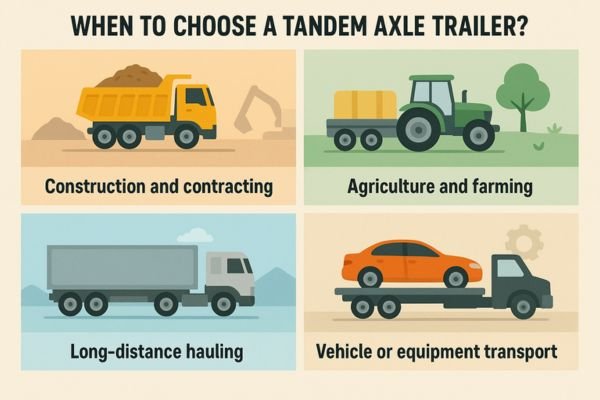
Conclusion: Which One Should You Choose?
By now, you’ve learned that choosing between a single axle and a tandem axle trailer is less about preference—and more about purpose.
A single axle trailer is best for lighter work. It’s cheaper, easier to move, and simpler to maintain. It’s great for casual users, homeowners, and small businesses that don’t need to carry heavy or oversized loads. If fuel savings, maneuverability, and cost are top priorities, this is your go-to choice.
In contrast, a tandem axle trailer is made for tough tasks. It carries more weight, handles long distances better, and offers greater safety. It’s the smart option for professionals who haul equipment, run farms, or tow vehicles often. You’ll pay more up front and in maintenance—but it pays off with better performance and durability.
Frequently Asked Questions
1. What is the main difference between a single axle and a tandem axle trailer?
A single axle trailer has one axle and two wheels, making it lighter, easier to maneuver, and more affordable. A tandem axle trailer has two axles and four wheels, offering greater load capacity, stability, and durability for heavy-duty hauling.
2. Which trailer type is better for beginners?
A single axle trailer is generally better for beginners because it’s lighter, easier to tow, and simpler to park or reverse in tight spaces.
3. Do tandem axle trailers require special licenses or brakes?
Yes, in many regions tandem axle trailers may require brakes and, depending on weight, may need special registration or licensing. Single axle trailers often avoid these requirements because of their lower load capacity.
4. Which trailer is more cost-effective in the long run?
If you only haul small loads occasionally, a single axle trailer is more cost-effective. However, for frequent heavy-duty use, a tandem axle trailer provides better long-term value despite its higher upfront and maintenance costs.
5. How do I choose between a single axle and a tandem axle trailer?
Base your choice on how much weight you plan to haul, how often you’ll use the trailer, and the type of roads you’ll travel. For light, occasional use, choose a single axle. For heavy, frequent, or long-distance hauling, a tandem axle is the better option.








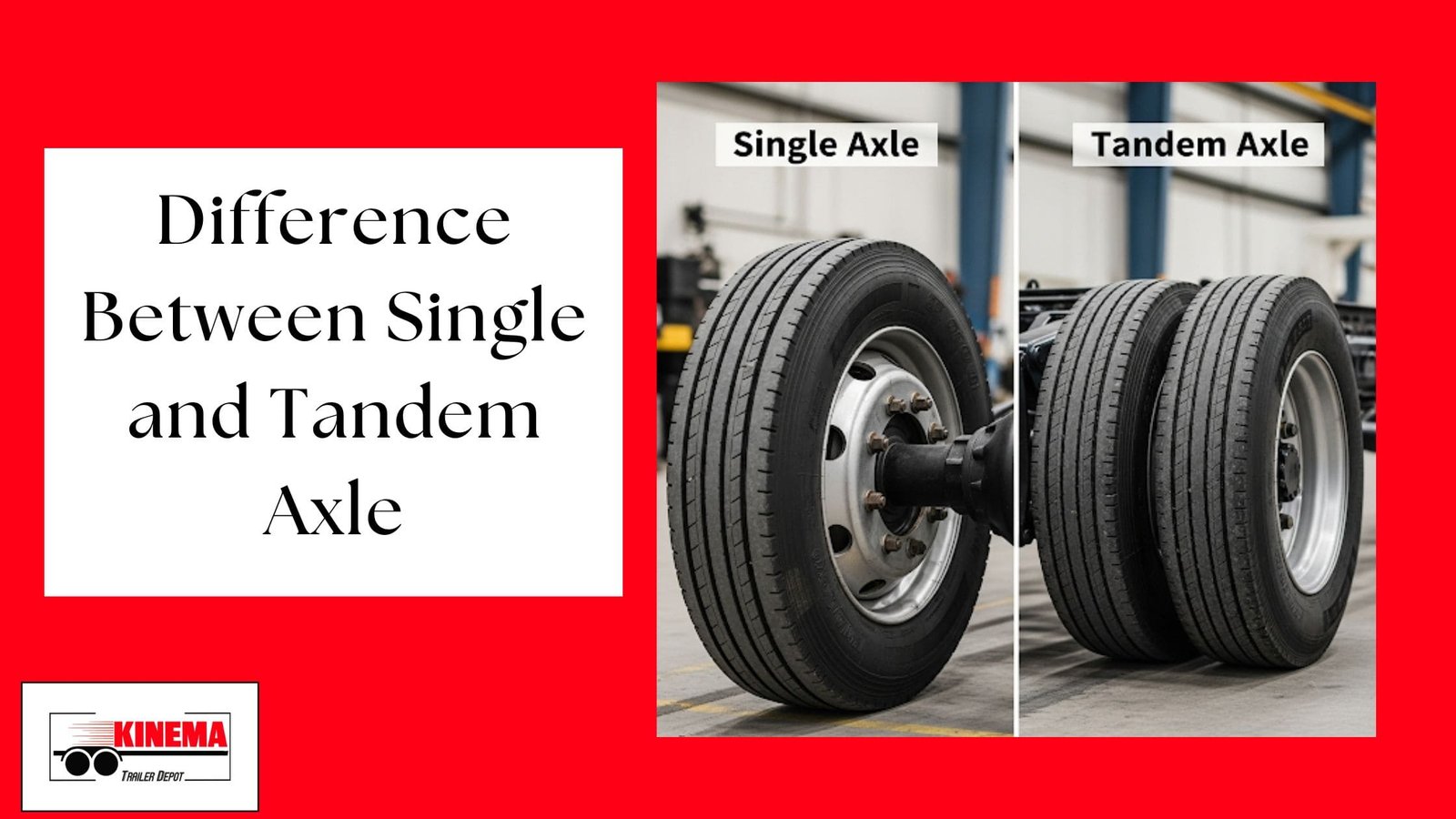
Leave a Reply